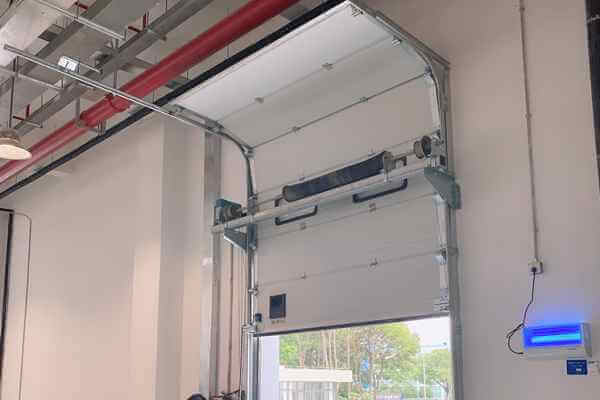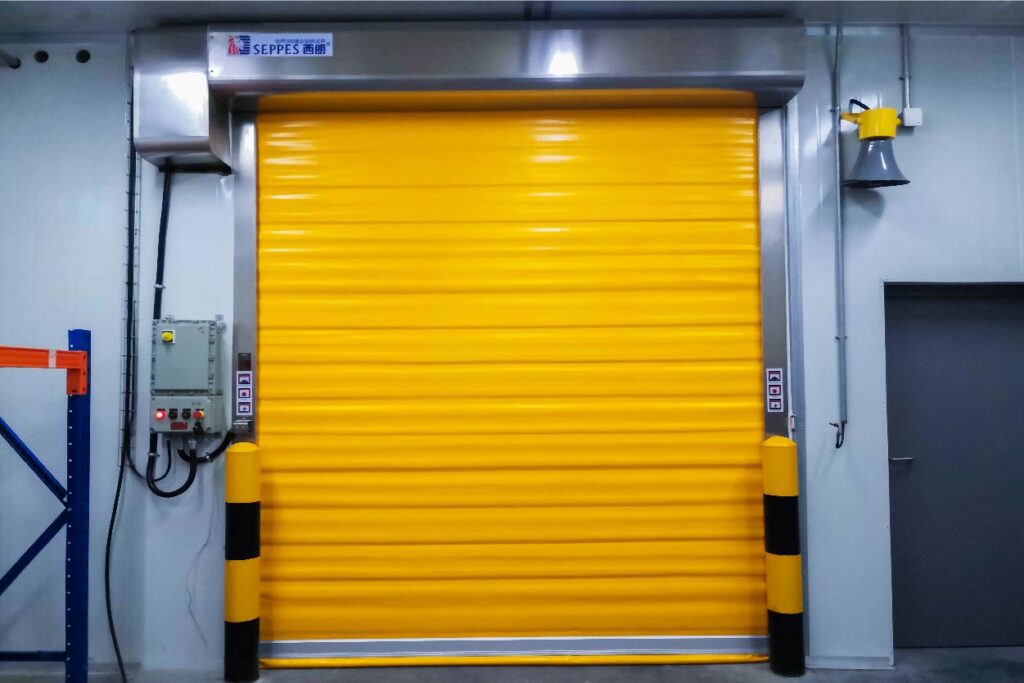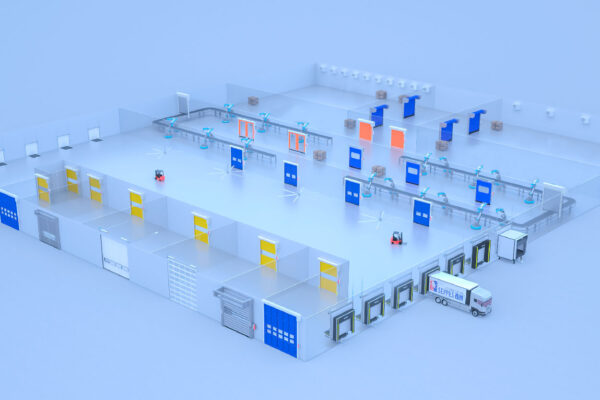Oportunidades y retos en el panorama mundial y regional de 2025
El panorama económico y geopolítico mundial seguirá evolucionando en 2025. La iniciativa china "Belt and Road" seguirá promoviéndose, las relaciones energéticas y comerciales de Rusia con la Unión Europea (UE) seguirán ajustándose y las políticas arancelarias entre los Estados miembros de la Unión Económica Euroasiática (UEEA) se integrarán más. En este contexto, Kazajstán, estratégicamente situado en la encrucijada de Europa y Asia y que está desarrollando importantes puertos nodales como Almaty y Khorgos, está acelerando su transformación en un centro logístico y manufacturero regional, impulsando la creciente demanda de Kazajstán Puerta industrial soluciones que cumplen las normas más estrictas de durabilidad y seguridad.
En este contexto, el mercado de puertas industriales de Kazajstán ha experimentado oportunidades de crecimiento sin precedentes: por un lado, las industrias de extracción de petróleo y gas, minería, cadena de frío, logística moderna y otras han experimentado un aumento de la demanda de puertas industriales de alto rendimiento; por otro lado, las estrictas normas internacionales y locales, las políticas de comercio transfronterizo y las presiones de control de costes también han aumentado los requisitos para compradores y proveedores. Este artículo le ayudará a comprender la adquisición y aplicación de puertas industriales en Kazajstán, desde el conocimiento del mercado, la selección de productos, la certificación de conformidad, el comercio internacional, la estrategia de proveedores, hasta la instalación y el mantenimiento en la nueva situación.
Visión general del mercado de las puertas industriales en Kazajstán
Tamaño del sector y previsión de crecimiento
Se espera que el mercado de puertas industriales de Kazajistán crezca a una tasa de crecimiento anual compuesto (CAGR) de 8-10% durante 2020-2025.
Principales aplicaciones derivadas: corredores logísticos de yacimientos petrolíferos (~30%), grandes plantas mineras (20%), almacenes de cadena de frío e industria alimentaria (25%), modernos centros logísticos (15%) y otros (10%).
Producción local frente a dependencia de las importaciones
La producción de puertas industriales en Kazajstán se lleva a cabo principalmente por pequeñas y medianas empresas, los productos a simples puertas enrollables, puertas de almacenamiento, la capacidad de producción representa alrededor de 20% del mercado.
El 80% restante de la demanda depende de las importaciones, siendo los principales países de origen en el siguiente orden: China (unos 45%), Rusia (20%), Bielorrusia (5%), Alemania/Italia (5%), otros (5%).
Puntos débiles del mercado
Clima extremo: hasta -40 °C en invierno y +40 °C en verano, probando los materiales de las puertas, las juntas y los sistemas de accionamiento.
Exigencia de alto nivel: A prueba de polvo, a prueba de explosiones, a prueba de fuego, aislamiento térmico, nivel de resistencia a la presión del viento hasta 8-10.
Logística y eficacia en el despacho de aduanas: La contratación multinacional tiene que ocuparse de múltiples declaraciones de aduanas, el IVA y los procesos de certificación de la CAO, lo que aumenta el plazo de entrega y los riesgos de coste.
Principales tipos de puertas industriales y escenarios de aplicación
Puertas enrollables de alta velocidad

Aplicaciones típicas: tránsito logístico de yacimientos petrolíferos, canal de aislamiento de zonas de plantas químicas.
Parámetros básicos: velocidad de apertura y cierre de 1,5-2,0 m/s, cortina de PVC o poliéster reforzado de alta estanqueidad; nivel de presión del viento de hasta 6-8.
Ventajas e inconvenientes: respuesta rápida, ahorro de energía y reducción del polvo, pero la resistencia al impacto es inferior a la de los paneles metálicos de las puertas.
Puertas basculantes seccionales

Aplicaciones típicas: almacenes de cadena de frío, plantas de procesamiento de alimentos, modernos centros logísticos.
Parámetros básicos: espesor de la puerta 40-50mm (relleno de espuma de PU), aislamiento térmico conductividad térmica ≤ 0,35 W / (m²-K); presión del viento 8-10 nivel;
Ventajas e inconvenientes: excelente aislamiento térmico y acústico y resistencia al viento, diseño modular para facilitar el mantenimiento, pero menor velocidad de apertura y cierre (0,2-0,3 m/s).
Puertas industriales a prueba de explosiones

Aplicaciones típicas: plantas químicas, zonas de mantenimiento de tuberías y almacenes de materiales inflamables y explosivos.
Parámetros básicos: Normas ATEX/IECEx, cuadro eléctrico antideflagrante, motores sin chispas, grado de estanqueidad hasta IP66;
Ventajas e inconvenientes: alta seguridad, dura certificación antideflagrante, coste y mantenimiento relativamente elevados.
Puertas Industriales Corta-Fuegos (Puertas Corta-Fuegos)

Aplicaciones típicas: centrales eléctricas, laboratorios de investigación, garajes de varios pisos.
Parámetros básicos: resistencia al fuego 60-120 minutos (EN 1634, certificación UL 10C); banda de estanqueidad al humo, dispositivo de cierre automático;
Ventajas e inconvenientes: satisface las necesidades de protección de la vida y seguridad, pero la placa de la puerta es pesada, la apertura y el cierre necesitan un mecanismo especial de accionamiento y amortiguación.
Puertas especiales a medida (puertas para cámaras frigoríficas / puertas para chorro de arena, etc.)

Puertas de cámaras frigoríficas: Apertura y cierre estables a baja temperatura (-40°C), densidad de llenado ≥ 48 kg/m³;
Limpieza con chorro de arena de las puertas de las habitaciones: Capa interior con cortina protectora de PVC y revestimiento antiabrasivo; capa exterior de acero de alta resistencia;
Ventajas e inconvenientes: ciclos de mantenimiento muy específicos y flexibles, pero ciclos de diseño y certificación más largos.
A continuación se presentan los cinco tipos principales de puertas industriales que suelen encontrarse en el mercado kazajo, junto con sus aplicaciones típicas, parámetros técnicos básicos y ventajas clave, y por último opciones opcionales de sustitución.
Principales tipos de puertas industriales y escenarios de aplicación
| Tipo de puerta | Aplicaciones típicas | Parámetros básicos | Principales ventajas | Soluciones alternativas |
| Puerta de accionamiento rápido enrollable | Corredor logístico de yacimientos petrolíferos, aislamiento de plantas químicas | Velocidad de apertura y cierre 1,5-2,0 m/s; clase de resistencia a la presión del viento 6-8; material de la cortina PVC/poliéster reforzado; banda de sellado EPDM | Apertura y cierre rápidos, ahorro de energía y reducción del polvo | Puerta seccional: Para un mayor aislamiento térmico y resistencia al viento, se puede utilizar la puerta seccional de tablero de espuma |
| Puertas basculantes industriales | Cadena de frío, procesamiento de alimentos, moderno centro logístico | Grosor de la puerta 40-50 mm (45 kg/m³ de espuma de PU); conductividad térmica ≤ 0,35 W/(m²-K); presión del viento 8-10 nivel; velocidad 0,2-0,3 m/s. | Aislamiento, aislamiento acústico, fuerte resistencia a la presión del viento; modularización y fácil mantenimiento | Puerta enrollable de alta velocidad: Para una apertura y cierre rápidos, combine una cortina de alta velocidad con una cortina aislante. |
| Puertas industriales antideflagrantes | Plantas químicas, zonas de mantenimiento de tuberías | ATEX/IECEx; caja de control eléctrica antideflagrante; motor antichispas; clase de protección IP66 | Alta seguridad, certificación antideflagrante | Puerta basculante seccional con kit antideflagrante |
| Puertas industriales cortafuegos | Centrales eléctricas, laboratorios, garajes de varios pisos | Resistente al fuego 60-120 min (EN 1634/UL 10C); banda de sellado antihumo; mecanismo de cierre automático | Retrasar la propagación del fuego, para proteger la seguridad del personal | Puerta rápida ignífuga: apertura y cierre más rápidos con el mismo nivel de prestaciones ignífugas |
| Puertas especiales a medida (cámara fría / chorro de arena) | Almacén frigorífico, sala de chorro de arena | Puerta refrigerada: Funcionamiento a -40 °C; lámina de 48 kg/m³ de espuma de PUPuerta arenada: Cortina antiabrasiva de PVC + chapa de acero de alta resistencia + revestimiento antiabrasivo | Protección específica, resistencia a bajas temperaturas/impactos | Puerta rápida enrollable + cortina de PVC: aislamiento rápido/antifricción |
Últimas normas y requisitos de conformidad para 2025
Normas internacionales
ISO 9001 (Gestión de la Calidad) e ISO 14001 (Gestión Medioambiental) como requisitos básicos de calidad y medio ambiente;
Marcado CE (norma de seguridad de la UE), certificación UL (norma de seguridad de EE.UU.) y EN 13241 (norma de la UE sobre influencias externas en puertas industriales).
Normas regionales/locales
GOST R: Kazajstán sigue la serie rusa GOST de normas obligatorias sobre materiales, construcción y protección contra incendios.
Certificación EAC (Marca de conformidad de la UEEA): Certificación armonizada de los requisitos medioambientales y de seguridad de los productos para los Estados miembros de la Unión Económica Euroasiática.
Proceso de certificación
Pruebas de laboratorio: resistencia a la corrosión del panel de la puerta, resistencia al fuego, resistencia a la presión del viento y otros elementos;
Inspección por terceros: Auditoría in situ de la organización EAC/CE y auditoría de fábrica;
Ciclo de documentación: Se tarda entre 8 y 12 semanas en preparar y probar todo el conjunto de documentos.
Actualizado para 2025
La Unión Económica Euroasiática ha armonizado y actualizado la clasificación de eficiencia energética de los sistemas de control electrónico a un mínimo de IE2;
La nueva norma EN sobre puertas cortafuegos refuerza los requisitos sobre materiales ignífugos para los sellos cortahumo y los pasos próximos a la puerta.
Comercio internacional e implicaciones de la política arancelaria
Preferencias arancelarias de la UEEA
Los productos de China, Rusia, Bielorrusia y otros países miembros disfrutan de aranceles de importación nulos o inferiores a 5%;
Las políticas preferenciales reducen significativamente la ventaja de costes de los fabricantes chinos en el mercado kazajo.
Ventajas logísticas de la Franja y la Ruta
Línea China-Europa: La línea Alashankou-Khorgos acorta el tiempo de transporte hasta 10-14 días;
Sinergia portuaria: Aktu port-Khorgos transporte multimodal y procedimientos de despacho de aduanas cada vez más simplificados.
Sanciones y barreras comerciales
Las sanciones contra algunas empresas rusas afectaron al suministro de maquinaria y piezas de equipos, lo que obligó a desplegar cadenas de suministro alternativas;
Frecuentes retrasos en la revisión de documentos en el despacho de aduanas extracomunitarias para equipos europeos.
Tarifas y sensibilidad a los costes
Aranceles de importación: unos 5-15% para productos de países no pertenecientes a la UEEA;
Impuesto sobre el Valor Añadido (IVA): 12%-14%;
Los costes combinados de transporte, despacho de aduanas y almacenamiento pueden suponer entre 10 y 12% del valor total del envío y deben incluirse en el análisis del coste total de propiedad (TCO).
Selección de proveedores y estrategias de aprovisionamiento
Comparación local frente a internacional
| Dimensión | Proveedores locales | Proveedores internacionales |
| Categorías de productos | Productos en su mayoría estandarizados, personalización limitada | Tipos completos, personalización multinivel |
| Cumplimiento de la certificación | Certificación GOST/EAC, plazo de entrega corto | Normas CE/UL/EN, certificaciones de gama alta |
| Estructura de costes | Sin aranceles, precio unitario más alto | Bajo coste de fabricación con aranceles |
| Plazos de entrega | Entrega en 2-4 semanas | 30-40 días para el transporte marítimo, 10-14 días para el transporte terrestre |
Ventajas de los proveedores chinos
Precio ventajoso: Incluso teniendo en cuenta los bajos aranceles, la fabricación en China sigue siendo 20-30% inferior a la de Europa y Estados Unidos;
Capacidad de personalización: desde los materiales hasta los sistemas de accionamiento y las formas de las juntas pueden configurarse a la carta;
Apoyo a la certificación: La mayoría de los fabricantes pueden proporcionar un conjunto completo de documentos de certificación, como EAC, CE, ISO, etc.
Ventajas de los productos europeos/americanos
Tecnología punta: protección hermética, la vida útil del motor y el sistema de control inteligente son más maduros;
Servicio postventa: red de servicio mundial, respuesta puntual, asistencia localizada disponible.
Negociación y puntos contractuales
Modelo de reparto de precios: comparar el coste de FOB, CIF y DDP;
Garantía y piezas de desgaste: aclaración del periodo de garantía, ciclo de suministro de piezas de repuesto y coste;
Formas de pago: L/C, T/T, D/P, etc. balance de riesgos y costes.
Gestión de costes de instalación, mantenimiento y ciclo de vida
Preparación previa a la instalación
Medida de la apertura de la puerta: precisión de ±5 mm, distancia de seguridad reservada;
Preimplantación de cimientos: ubicación de la vía y de la caja de control eléctrico y preinstalación de distribución de energía;
Acoplamiento ambiental: a prueba de polvo, anticorrosión y control de temperatura necesita confirmación de sincronización.
Mantenimiento regular
Inspección mensual: limpieza de orugas, lubricación de poleas;
Mantenimiento trimestral: comprobación del motor y de los componentes antideflagrantes, comprobación del inflado del airbag;
Mantenimiento mayor anual: sustitución de juntas, comprobación de la integridad del sistema de protección contra incendios/explosiones.
Solución de problemas y recuperación
Defectos comunes: atasco del cuerpo de la puerta, sobrecalentamiento del motor, fuga de la junta;
Rápida recuperación: kit de piezas de repuesto estandarizadas + asistencia técnica a distancia, tiempo de recuperación ≤ 24 horas.
Modelización del coste del ciclo de vida
Coste de adquisición inicial + Transporte y aduanas + Instalación + Mantenimiento anual + Consumo energético = Coste total de propiedad (TCO);
Se recomienda que las comparaciones de modelos se determinen en función del coste total de propiedad y no de un precio único.
Conclusión y perspectivas
Con la situación internacional y el entorno político más recientes en 2025, el abastecimiento y la aplicación de puertas industriales en Kazajstán deberán tener en cuenta la conformidad y la certificación, la diversificación de la cadena de suministro y la optimización del coste del ciclo de vida.
Información clave: Las preferencias arancelarias de la UEEA y las ventajas de la logística de línea China-UE abren una situación ventajosa para los proveedores chinos en términos de costes y plazos.
Tendencias futuras: Las puertas industriales inteligentes (monitorización IoT, autodiagnóstico), los materiales ecológicos y de bajo consumo y la estructura modular se convertirán en la corriente principal;
Sugerencias para la acción: Actualizar dinámicamente la biblioteca de normas, construir centros regionales de piezas de recambio, establecer una cooperación a largo plazo con los proveedores y llevar a cabo una formación técnica localizada para lograr una competitividad sostenible.
FAQ (Preguntas más frecuentes)
¿Cuáles son los principales tipos arancelarios para importar puertas industriales a Kazajstán?
Los derechos de aduana rondan los 5-15% para los países no pertenecientes a la UE y los 12-14% para el IVA.
¿Cómo puedo estar seguro de que los productos que elijo cumplen las normas EAC y CE?
Pida certificados EAC/CE, informes de laboratorio y auditorías de fábrica al comprar.
¿Cómo garantizar la estanqueidad de la puerta a -40 °C?
Elija juntas elásticas de EPDM para bajas temperaturas y realice in situ un llenado de nitrógeno o una prueba de resistencia al frío.
¿En qué términos debo fijarme al negociar un contrato de importación?
Condiciones de precio (FOB/CIF/DDP), condiciones de garantía y suministro de piezas de repuesto, plazos de entrega e incumplimiento de contrato.
¿Cómo evaluar el coste total de propiedad (TCO) de una puerta industrial?
Fórmula completa: Coste inicial + Transporte/despacho aduanero + Instalación + Mantenimiento + Consumo energético, que se recomienda analizar en comparación con el modelo presupuestario.

